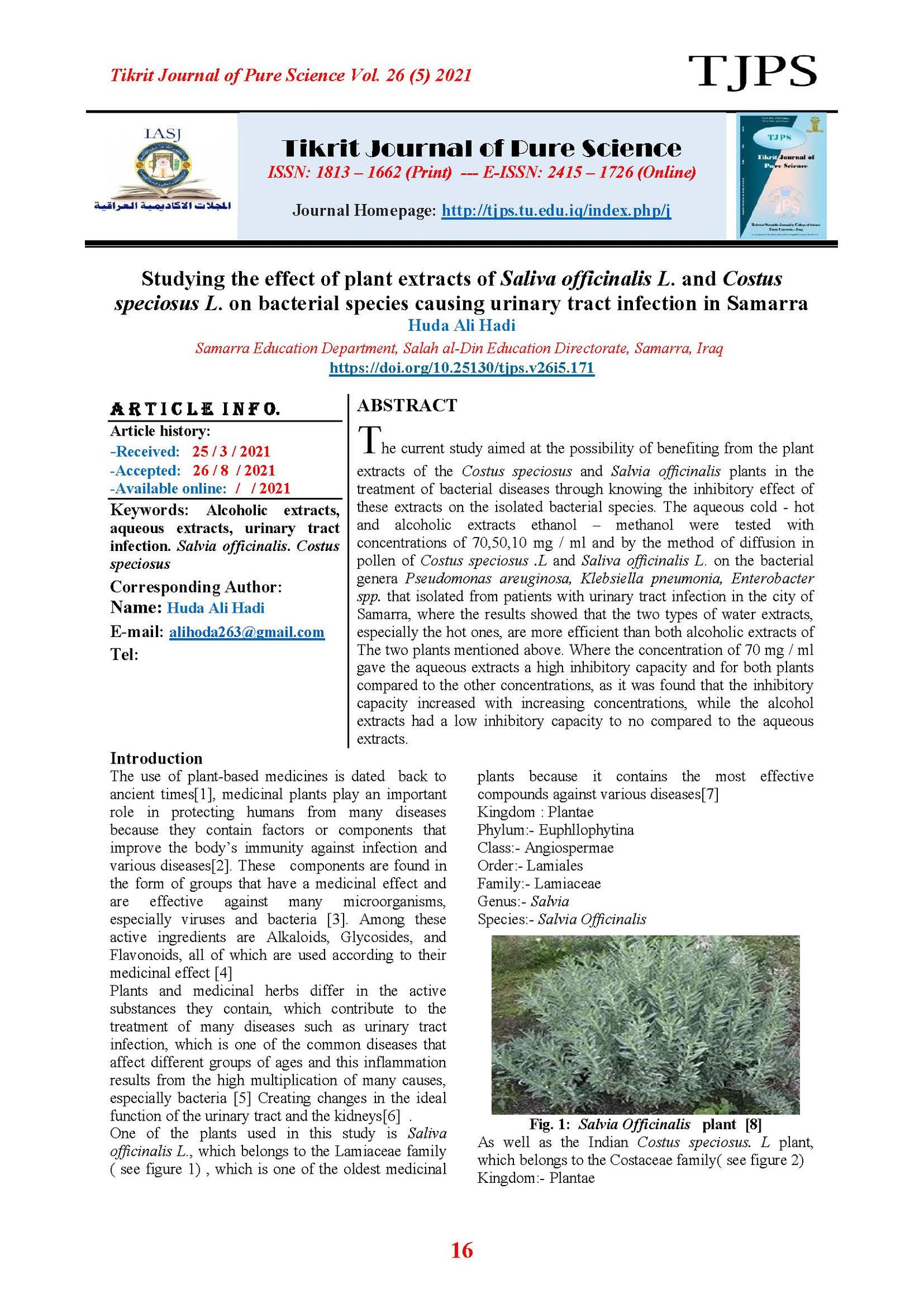Studying the effect of plant extracts of Saliva officinalis L. and Costus speciosus L. on bacterial species causing urinary tract infection in Samarra
Main Article Content
Abstract
The current study aimed at the possibility of benefiting from the plant extracts of the Costus speciosus and Salvia officinalis plants in the treatment of bacterial diseases through knowing the inhibitory effect of these extracts on the isolated bacterial species. The aqueous cold - hot and alcoholic extracts ethanol – methanol were tested with concentrations of 70,50,10 mg / ml and by the method of diffusion in pollen of Costus speciosus .L and Saliva officinalis L. on the bacterial genera Pseudomonas areuginosa, Klebsiella pneumonia, Enterobacter spp. that isolated from patients with urinary tract infection in the city of Samarra, where the results showed that the two types of water extracts, especially the hot ones, are more efficient than both alcoholic extracts of The two plants mentioned above. Where the concentration of 70 mg / ml gave the aqueous extracts a high inhibitory capacity and for both plants compared to the other concentrations, as it was found that the inhibitory capacity increased with increasing concentrations, while the alcohol extracts had a low inhibitory capacity to no compared to the aqueous extracts.
Article Details

This work is licensed under a Creative Commons Attribution 4.0 International License.
Tikrit Journal of Pure Science is licensed under the Creative Commons Attribution 4.0 International License, which allows users to copy, create extracts, abstracts, and new works from the article, alter and revise the article, and make commercial use of the article (including reuse and/or resale of the article by commercial entities), provided the user gives appropriate credit (with a link to the formal publication through the relevant DOI), provides a link to the license, indicates if changes were made, and the licensor is not represented as endorsing the use made of the work. The authors hold the copyright for their published work on the Tikrit J. Pure Sci. website, while Tikrit J. Pure Sci. is responsible for appreciate citation of their work, which is released under CC-BY-4.0, enabling the unrestricted use, distribution, and reproduction of an article in any medium, provided that the original work is properly cited.
References
[1] Mike, O. Soladoye, N. Amusa, O. Raji-Esan, C. and A yanbamiji, T. (2010). Ethnobotanical survey of Anti-cancer plants in Ogun state Nigeria (PDE). Annals of Biological Research. 1(4):261-273.
[2] Sumit, D. Ripunjoy, B. and Nishant, N. (2014). A Review on Immune Modulatory Effect of some Traditional Medical Herbs. Journal of pharmaceutical , Chemical and Biological Sciences, 2(1):33-42.
[3] Makkar, P. Siddhuraju, P. and Becker K. (2007). Plant secondary metabolites, Humana press, Totowa, NJ, USA.
[4] Cowan, M. (1999). Plant produets as antimicrobial agents clin. Microbiol. Rev- 12(4): 564-582.
[5] Schulz, L., Hoffman, R., Pothof, J.,and Fox, B. (2016). Top ten myths regarding the diagnosis and treatment of Urinary tract infections. The Journal of Emergency Medicine, 51(1) :25-30
[6] Hojati, Z. ; Zamanzad, B. ; Hashemzadeh,M.; Molaie,R. and Gholipour, A. (2015). Detection of fim H gene in uropathogenic Escherichia coli Strains Isolated From Patients With Urinary Tract Infection , Faculty of Medicine, Shahrekord University of Medical Sciences, 8(2): 1-3
[7] Bors, W.; Michel, C.; Stettmaier, K;Lu, Y.and Foo, L.Y. (2004). Antioxidant mechanisms of polyphenolic caffeic acid oligomers. Constituents of Salvia officinalis , GSF Research Center, p: 301-311
[8] Simon, J.E.; Chadwick, A.T. and Clakel, L.E.(1984).The Scientific Literatue On Selected Herbs, and Aromatic and Medical Plants of The Temperate Zone.Archon Books;pp:770
[9] Santosh ,G;M and Dayala ,D; (2015) .Molecular Characterization of spotted spiral ginger Insulin plant . P:6-7
[10] Ariharan , V.N.; Meena , V.; Rajakokhila , M. and Nagendra, P.(2012). Antibacterial activity of Costus speciosus rhizome extract on some pathogenic bacteria. Internal. J. Adv. Life Sci., Vol.4. pp.: 24-27.
[11] Bogdadi, Hamed Abdelsalam Abdelah, Kokoska Ladislav, Havlik Jaroslav,Kloucek Pavel, Rada Vojtech, and Karel, Vorisek (2007): in vitro Antimicrobial Activity of some Libyan Medicinal plant 45,NO.5.pp.386-391.
[12] Sani, I., Abdulhamid, A., Bello, F. (2014). Phytochemical composition of ethanolic and aqueous extracts of the leaves, stembark, root, fruits and seeds. Journal of Scientific and Innovative Research, 3(5):523-526.
[13] Sexena, G.; Farmer, S.; Hancoc, R. and Towers, G. (1999). Antimicrobial compounds from Alnus raba Int Jof pharmacognosy. 33-36.
[14] Draughon, F. A. (2004). Use of botanicals as biopreservatives in foods. Food Technology. 58(2): 20- 28.
[15] Montville, T. J. and K. R. Mattews (2005). Food Microbiology: an Introduction.ASM Press. New York .p: 415-436
[16] AL-Shekhany, Y. N.M. (2015). Determination of alkaloid and glycoside contents of some Iraqi species of Astragalus, Heliotropium and Salvia and their antimicrobial and antioxidant activities .PhD thesis . University of Tikrit.
[17] Suzan, K; Manal, O .(2016). Phytochemical screening and antimicrobial activities of Costus speciosus and Sea Qust. 28 (1): 389-393.
[18] Nweze EL, Okafor JL, Njoku O (2004). Antimicrobial Activityies of Methanolic extracts of Trume guineesis (Scchumn and Thorn) and Morinda lucinda used in Nigerian Herbal Medicinal practice. J. Biol. Res. Biotech. 2(1): 34-46.
[19] Vinod ,D. ( 2014) . Physical Characterisation of Costus speciosus (Koenig Ex Retz.) Smith – A well Known Ayurvedic Drug Plant, ISSN 2277-4297, P;1-6.
